Ducati 996 SPS Pista
With Ian Falloon
With the long line of Ducati factory Superbike racing V-twins now at an end it’s worth recalling the incredible success of some earlier engine designs, notably the Desmoquattro. Between 1990 and 2000 the 851, 888, 916, and 996 Desmoquattro won eight World Superbike Championships.
Their riders, headed by Doug Polen, Carl Fogarty and Troy Corser, won 163 World Superbike races, providing an astonishing winning ratio of 52 per cent. There has never been any other Ducati racing engine as successful or dominant.
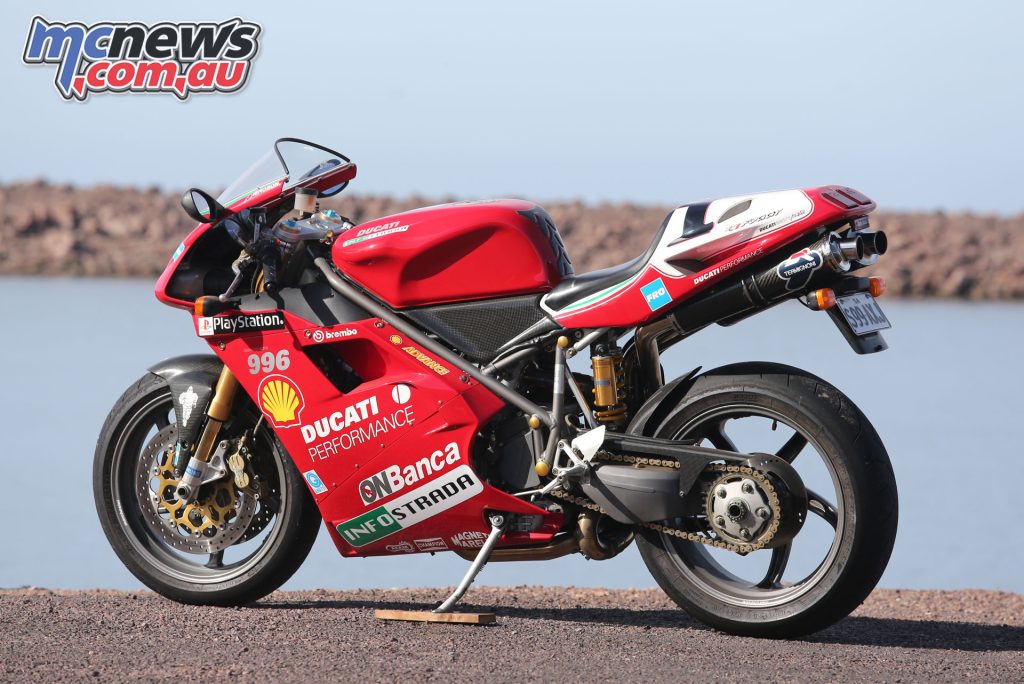
The Desmoquattro grew out of the air-cooled two-valve 750 F1 in 1986 and represented a huge technological step for Ducati. Introducing liquid-cooling, four-valve Desmodromic cylinder heads, and a fully mapped electronic fuel injection and ignition system, it was generations ahead of previous Ducatis. And Ducati immediately saw a racing future for the new engine, primarily in the new World Superbike Championship that began in 1988.
As a low volume manufacturer Ducati was only required to produce homologation models in small numbers, releasing limited edition 851 Sport Production homologation racers from 1989. They followed this with the 888 SP and SPS in 1992 and the 916 SP in 1994. In 1997 they produced the 916 SPS to homologate new 996cc crankcases.
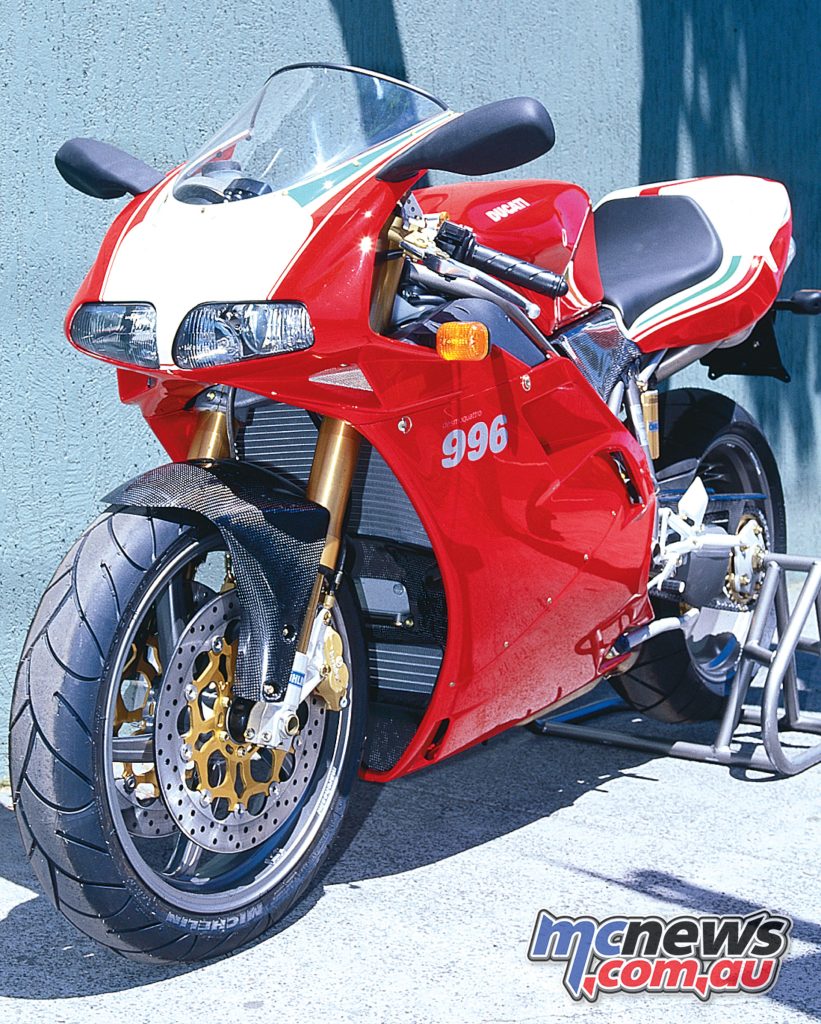
Despite new homologated stronger crankcases with a wider cylinder stud pattern Ducati failed to win the 1997 World Superbike riders’ and constructors’ championships. This was the first time they hadn’t won the constructors’ championship since 1990.
But the 996 made amends; Carl Fogarty winning both the 1998 and 1999 World Superbike Championships on the factory 996. Steve Martin also won the 1999 Australian Superbike Championship on a 996RS and Troy Bayliss the 1999 British Superbike Championship on a similar machine.
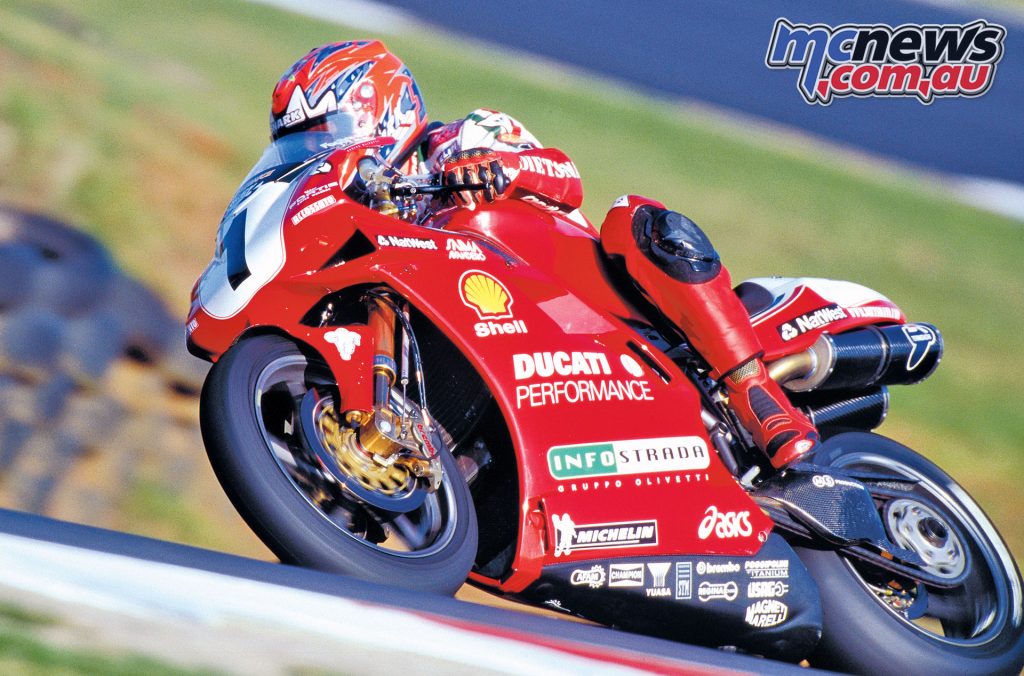
By 2000 the Testastretta was about to supersede the Desmoquattro but as Ducati was still racing the Desmoquattro in World Superbike a series of homologation specials was produced between 1998 and 2000.
While the 916 SPS evolved into the 996 SPS, for specific homologation of certain components Ducati offered very small numbers what they called the 916 SPS Fogarty Replica in 1998, and 996 SPS Factory Replica in 1999. It got very confusing because the factory never released official brochures for these limited edition homologation models and they were never widely available.
What separated the 996 SPS from the standard 996 Strada was the engine and ignition system. The SPS retained the earlier Weber Marelli EFI with P8 processor and twin injectors per cylinders. With an 11.5:1 compression ratio, 98 mm pistons, wider stud cylinder heads with larger valves (36 mm inlet and 30 mm exhaust) and titanium con-rods the engine produced 123 horsepower at 9,500 rpm.
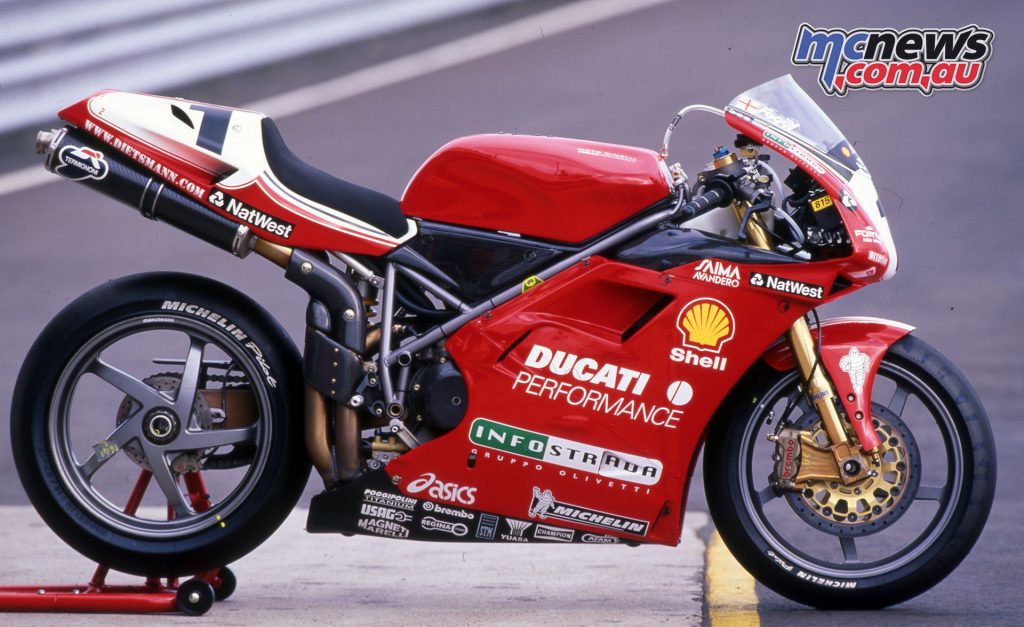
The 996 SPS was updated significantly for the 2000 Model Year. While the 996 cc Desmoquattro engine was unchanged, new suspension made it the finest example yet of its genre. The 43 mm Öhlins front fork now featured gold-coloured TiN coated fork legs and included some developments from the World Superbike racing program.
The 85mm steering lugs were from the Ducati Corse 996, and along with new, stiffer, triple clamps, the axle mounting height was reduced from 110 to 80mm. This allowed for an increase in the extension of the stanchions to provide more precise front-end control. The rear subframe was now constructed of aluminium tubing, using the same cross section as the Ducati Corse 996, and saving 0.5 kg.
The frame and wheels were “gun metal grey” this year and the total weight 3kg less than before, at 187kg dry. The result of these developments maintained the position of the 996 SPS as the world’s premier sports bike. It may not have been the fastest superbike, but the suspension improvements elevated the 996 SPS beyond that of even the newer generation Japanese and Italian machines. It was the purist evidence of racing improving the breed.
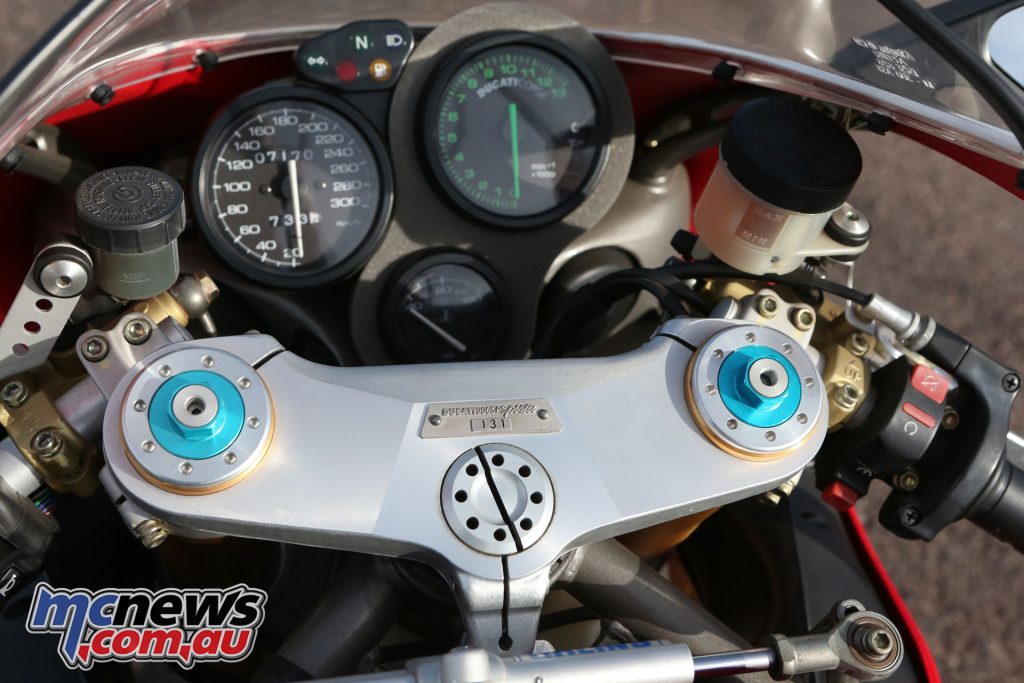
Following requests for more examples of the 996 SPS Factory Replica, another series was produced for 2000. Originally this was to be known as the 996 SPS 3, but it was officially known as the 996 Factory Replica 2, and was primarily for the homologation of new parts for the 996 Factory 2000 World Superbike racer. When released it was designated the “Pista”; Pista being Italian for circuit or track.
Aesthetically the SPS Pista was similar to the 1999 996SPS/FR (Factory Replica). A Ducati Infostrada Superbike team decal kit was offered in addition to unique tri-colour striping on the headlight fairing and seat. Each example also came with a limited edition numbered plaque affixed to the triple clamp.
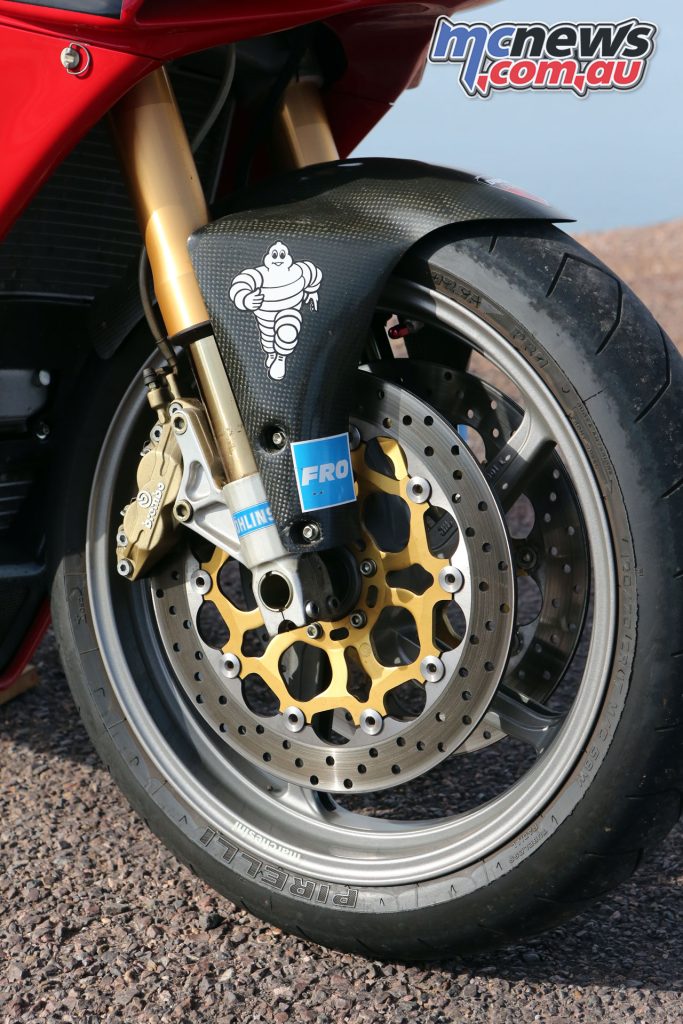
Today the 996 SPS Pista signifies the pinnacle of one of Ducati’s most significant lineages. Combining the highest specification production version of the Desmoquattro with timeless 916 styling resulted in an exceptional motorcycle. While the subsequent Testastretta was more powerful and refined, the Desmoquattro in SPS guise retained the brutishness and rawness that typified Ducatis of earlier eras.
As the total production of the 996 SPS Pista was only 149 it was one of the rarer production Ducatis of the modern era. Australia received only 15 examples and it arrived in late October 2000. This was after the release of the new 996R Testastretta for 2001. But as it was so rare the 996 SPS Pista has somehow slipped underneath the radar of collectable modern Ducatis.
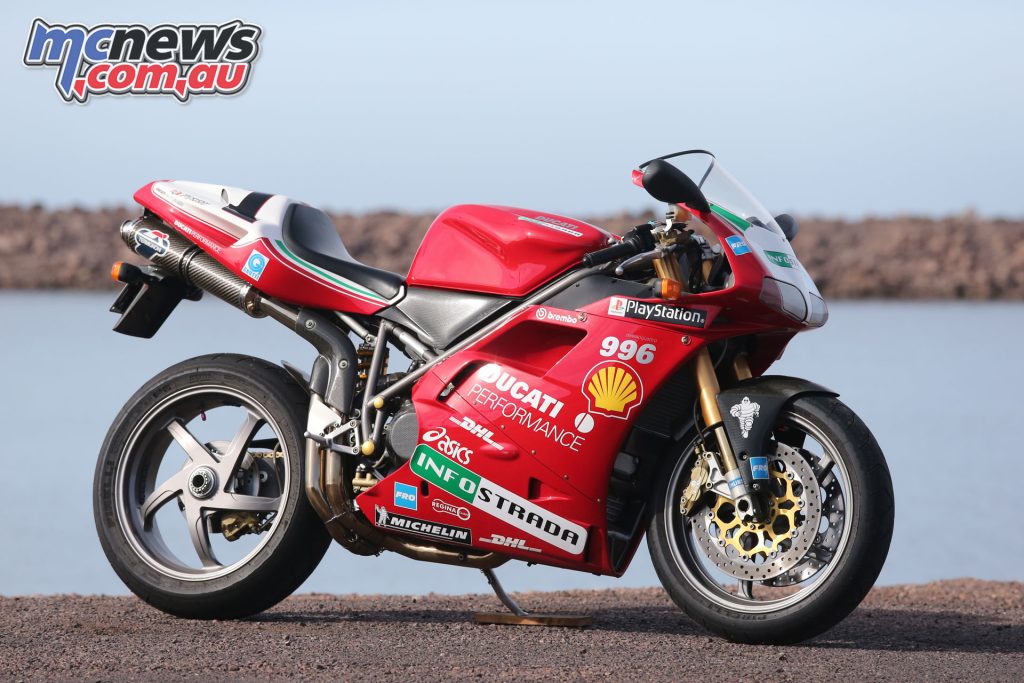
Ducati 996 SPS Pista Specifications
| Ducati 996 SPS Pista Specifications | |
| Engine | Liquid-cooled four-stroke, 90-degree L-twin cylinder, DOHC, Desmodromic, four-valve per cylinder, 996 cc |
| Bore x Stroke | 98 x 66 mm |
| Compression Ratio | 11.5:1 |
| Max Power | 90.5 kW [123 hp] @ 9500 rpm |
| Max Torque | 99 Nm @ 8000 rpm |
| Clutch | Hydraulically activated dry clutch |
| Tranmission | Six-speed gearbox |
| Frame | Tubular trestle frame, upper of high-strength steel |
| Front Suspension | 43 mm Ohlins fork, adjustable compression & rebound, 127 mm travel |
| Rear Suspension | Ohlins monoshock, rising rate, adjustable compression & rebound |
| Brakes | Dual 320 mm rotors, four-piston Brembo front calipers, single 220 mm rear rotor, two-piston Brembo caliper |
| Wheels | Alloy, 3.50 x 17 in (F), 5.50 x 17 in (R) |
| Tyres | 120/70-17 (F), 190/50-17 (R) |
| Rake | 23.5-24.5 degrees |
| L X W x H | 2095 x 690 x 1090 mm |
| Wheelbase | 1410 mm |
| Seat Height | 790 mm |
| Dry Weight | 190 kg |
| Top Speed | 270 km/h (claimed) |























